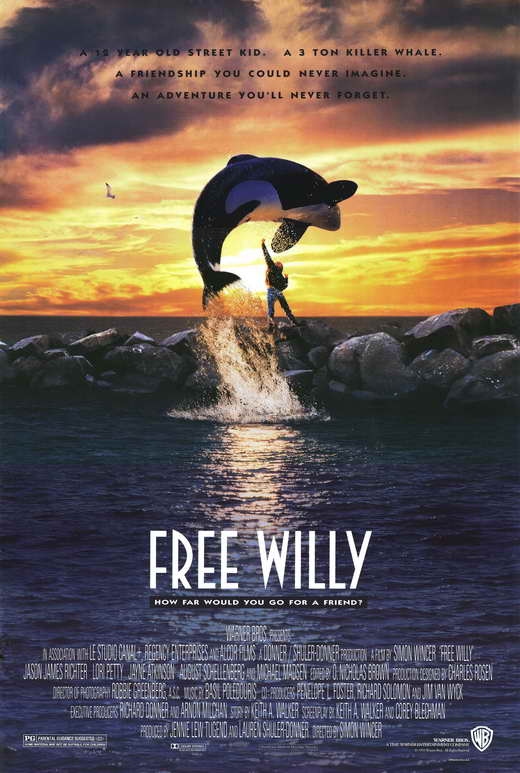 For this month, I would like to take a look at the “Free Willy” movies. It’s nothing special, since the story is what we’ve heard so many times before. A boy bonds with an animal and the entire movie is focused on them getting closer. What was new was that it hadn’t been done with a whale before. Anyways, let’s take a look at the first “Free Willy” movie, released in 1993.
For this month, I would like to take a look at the “Free Willy” movies. It’s nothing special, since the story is what we’ve heard so many times before. A boy bonds with an animal and the entire movie is focused on them getting closer. What was new was that it hadn’t been done with a whale before. Anyways, let’s take a look at the first “Free Willy” movie, released in 1993.
“Free Willy,” as I mentioned already, is about a boy and a whale, which for certain people, sounds like an awkward adaptation of the old tale about a boy and his dog. Whales are not as charismatic as dogs, not as easily trained, and cannot be hugged. Yet “Free Willy” works around the physical reality of the animal lead, which made it one of the summer’s best family pictures.
The movie stars Jason James Richter as Jesse, a 12-year-old orphan who is going through the rebellious, adolescent years of his life. He moves into a foster home, and even though his foster parents (the great Michael Madsen and Jayne Atkinson) are patient and loving, Jesse still acts rebellious towards them. He’s uncontrollable, insulting, distant, and disappears for hours at a time.
One day Jesse is caught spray-painting at the broken down “Adventure Park” near his home and is ordered to clean the graffiti as punishment. While cleaning away the mess he made on the walls of the aquarium, he meets Willy, an orca whale who was recently captured. One night, when Jesse has run away from home and is sitting under the moonlight near Willy’s tank, he notices that Willy reacts whenever Jesse plays his harmonica.
That’s where their friendship starts. Jesse and Willy both feel homeless, broken away from their real families – Willy because he has been captured; Jesse because his birth mother abandoned him and he cannot believe that she will come back for him.
Eventually two friendly workers at the aquarium, a trainer named Rae (Lori Petty, who voiced Livewire from “Superman: the Animated Series”) and a handyman named Randolph (August Schellenberg) see that Willy will only pay attention to Jesse. Overnight, Jesse now becomes the new trainer for Willy.
The scenes with Willy are very convincing. The filmmakers used a combination of a real whale and a handful of animatronic whales to create a flawless illusion. The part where Willy saves Jesse from drowning is impossible to see whether that whale is the actual whale or an artificial whale. The film also puts in the effort of giving Willy a personality. Actually, it does go a little too far. The late Roger Ebert said, “by the end of the movie, Willy spontaneously figures out how to nod his head for "yes" and shake it from side to side for "no," skills that I suspect a real orca would have little interest in developing.”
The plot involves the cunning, villainous owners of the park (Michael Ironside (who always plays a villain, doesn’t he) and Richard Riehle), who first want to use Jesse and Willy’s friendship, and then want to kill Willy for insurance money. That sets into motion the predictable, but no less effective, conclusion, in which the aspects of the boy, whale and family, are brought together nicely.
Ebert commented in his review, “"Free Willy" has a kind of gentle sweetness that I found very appealing.” It is about change – a young boy finding out who he is – and about adventure. The subplot involving “save the whales” makes it more than just an adventure, or an escapade. The screenplay is written intelligently. If you look at the relationship between Jesse and his foster parents, it has the ring of truth. The movie does appeal to the younger audiences (they may find it more accessible and definitely less frightening than “Jurassic Park”), and it’s smart enough to keep the adults attention as well.
Also, make sure to watch the credits. Michael Jackson’s “Will You Be There” plays. I find it strange that the Nostalgia Critic believes that the reason why “Free Willy” was such a hit was because of Michael Jackson singing the movie’s theme. However, the one thing that everyone harps on about is Willy jumping over a pile of rocks and not a net. I do say that I am with everyone in thinking why Willy didn’t do that. Maybe it was to build suspense if Willy could really do it and needed Jesse’s encouragement, but if Jesse did that earlier, than Willy could have leaped over the net.
In the end, watch this movie. It’s not terrible, definitely above average, but not really “that” good of a movie. Still, it’s watchable if you have little children with you.
Thanks for joining in on the first installment of “Free Willy Month.” Stay tuned next week when I talk about the sequel.
No comments:
Post a Comment